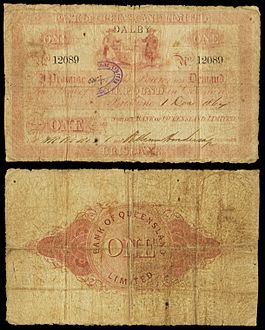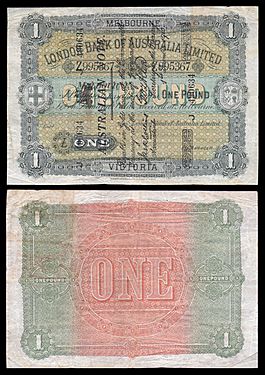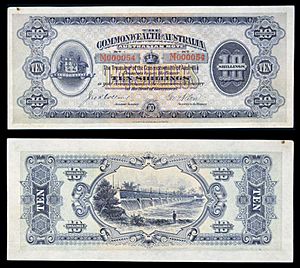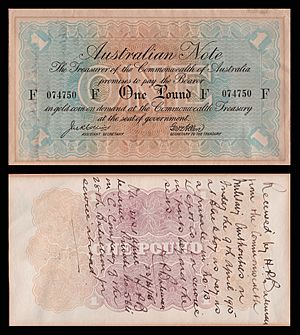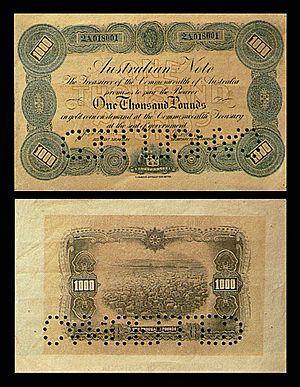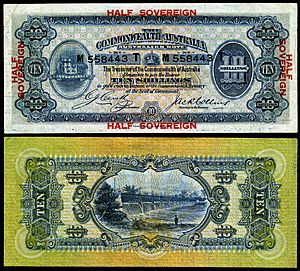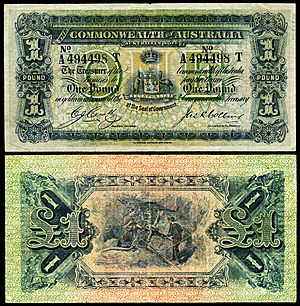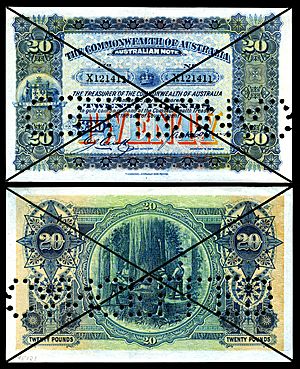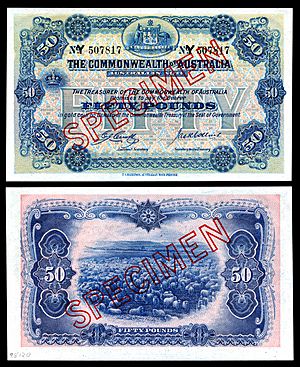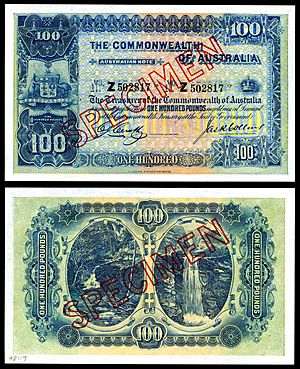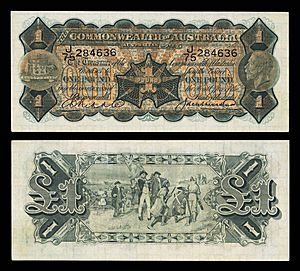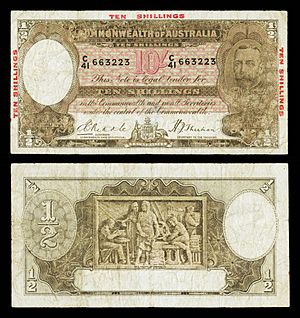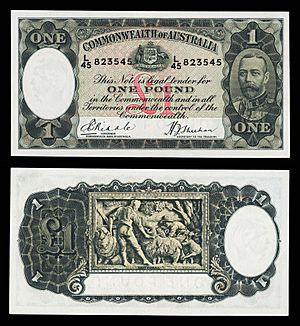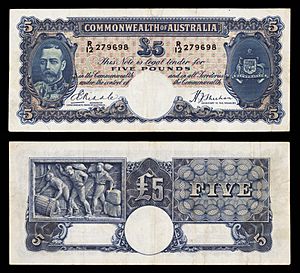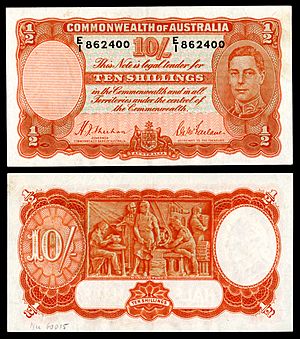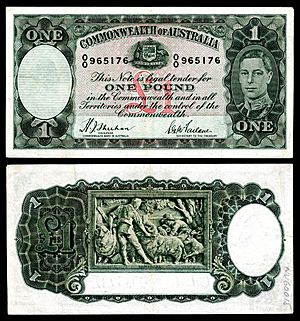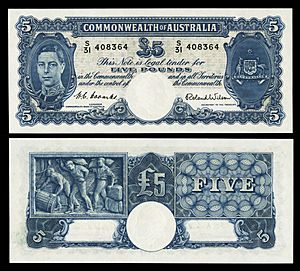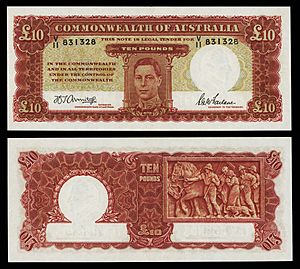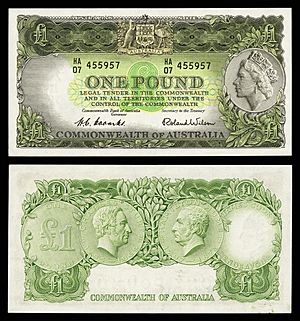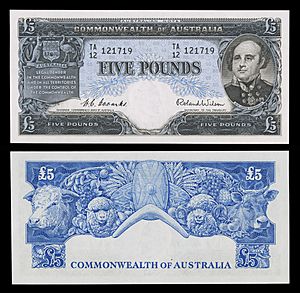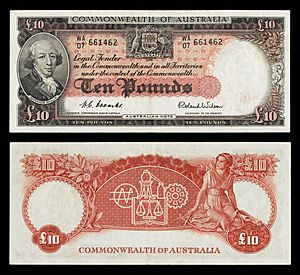Banknotes of the Australian pound facts for kids
The banknotes of the Australian pound were the paper money used in Australia before it switched to the Australian dollar. For a long time, many different private banks in Australia printed their own money. The very first one was the Bank of New South Wales in 1817. Even though people didn't have to accept these private bank notes by law, they were used and trusted by many.
Later, the Queensland government also printed its own special notes between 1866 and 1910. These were considered official money only in Queensland. The New South Wales government also made a small number of special notes in 1893.
A big change happened in 1910 when the Australian government passed a law called the Australian Notes Act. This law meant that after six months, private banks could no longer print their own money. It also said that any notes from state banks would no longer be official money. This law gave the Australian government the power to print, re-print, and cancel Australian notes. It also decided what amounts the notes would be, how they would be official money, and how much gold the government needed to keep to back up the notes.
To make sure private banks stopped printing money, another law was passed in 1910. This law put a big tax (10%) on any bank notes that private banks still printed or re-printed. In 1911, the Commonwealth Bank was created. At first, the Australian Treasury printed the banknotes. But in 1920, the Commonwealth Bank took over this job and created its own department just for printing notes.
Finally, on 14 February 1966, Australia changed its money system completely. The Australian pound was replaced by the decimal Australian dollar, which is divided into one hundred cents.
Contents
Australia's First National Banknotes (1910–1914)
The very first national paper money in Australia was called Superscribed banknotes. These were actually old notes from fifteen private banks and the Queensland government that the Australian government bought. They then printed the words "Australian note" over the top of them. These notes were used between 1910 and 1914.
You could find these notes in amounts of £1, £5, £10, £20, £50, and £100. Notes worth more than £10 are super rare today! For example, only two £20 notes are known to exist, and they are owned by private collectors. Some £50 notes are kept in special collections like the Reserve Bank of Australia. No £100 notes from this series are known to exist at all.
Who Printed the Superscribed Banknotes?
Here's a list of the banks and the Queensland government that originally issued these notes before they were overprinted:
| Bank Name | Main Location | Branches | Note Values | Years Active |
|---|---|---|---|---|
| Australian Bank of Commerce Limited | Sydney, NSW | Brisbane, Sydney | 1,5,10,50 | 1910–31 |
| Bank of Adelaide | Adelaide, SA | Adelaide | 1,5,10,20,50 | 1865–1980 |
| Bank of Australasia | London, England | Brisbane, Hobart, Melbourne, Perth, Sydney | 1,5,10,50,100 | 1835–1951 |
| Bank of New South Wales | Sydney, NSW | Adelaide, Melbourne, Perth, Sydney | 1,5,10,20,50,100 | 1817–1982 |
| Bank of Victoria Limited | Melbourne, Victoria | Melbourne | 1,5,10,20,50 | 1852–1927 |
| City Bank of Sydney | Sydney, NSW | Sydney | 1,5,10,20,50 | 1864–1918 |
| Colonial Bank of Australasia | Melbourne, Victoria | 1856–1918 | ||
| Commercial Bank of Australia Limited | Melbourne, Victoria | Hobart, Perth | 1,5 | 1866–1982 |
| Commercial Bank of Tasmania Limited | Hobart, Tasmania | Hobart, Launceston | 1,5,10,20 | 1829–1921 |
| Commercial Banking Company of Sydney Limited | Sydney, NSW | Sydney | 1,5,10 | 1834–1982 |
| English Scottish and Australian Bank Limited | London, England | Adelaide, Melbourne, Sydney | 1,5,10,20,50 | 1852–1970 |
| London Bank of Australia Limited | London, England | Adelaide, Melbourne, Sydney | 1,5,10,50,100 | 1852–1921 |
| National Bank of Australasia Limited | Melbourne, Victoria | Adelaide, Melbourne, Perth, Sydney | 1,5,10,20,50,100 | 1858–1982 |
| Queensland Government | Brisbane, Queensland | Brisbane | 1,5 | 1893–1910 |
| Royal Bank of Australia Limited | London, England | Melbourne, Sydney | 1 | 1888–1927 |
| Union Bank of Australia Limited | London, England | Adelaide, Hobart, Melbourne, Perth, Sydney | 1,5,10,20,50 | 1837–1951 |
| Western Australian Bank | Perth, WA | Perth | 1,5,10 | 1841–1927 |
Commonwealth Banknotes: The Australian Pound (1913–1965)
In 1913, Australia introduced its first truly national banknotes. These were available in amounts of 10 shillings (10s), £1, £5, and £10. By 1914, even larger notes were introduced: £20, £50, £100, and £1000. The £1000 note was not used much by the public. It was mostly used for transfers between banks. Most of these notes were later destroyed. A single cancelled £1000 note sold for a huge amount of money in 2007!
The designs of these notes changed quite quickly. From 1915, the 10s notes had a red "Half Sovereign" printed on them. The size of the £1, £5, and £10 notes was made smaller in the mid-1920s. Around the same time, a picture of King George V was added to the 10s up to £10 notes. These notes still mentioned that they could be exchanged for gold if you wanted. A new £1000 note with King George V's picture was designed but never actually released.
After the Great Depression started in 1933, Australian money could no longer be directly exchanged for gold. Because of this, new legal tender notes were designed. These new notes still featured King George V and came in 10s, £1, £5, and £10. These designs continued, with a picture of King George VI added in 1938. Even though £50 and £100 notes were planned for both these issues, they were never actually printed for public use.
Different Series of Australian Pound Banknotes
Here's a look at the different series of Australian pound banknotes issued between 1913 and 1965:
| Issue | Value (Dates) |
Banknote | Varieties | Images Size |
|---|---|---|---|---|
|
|
5 Shillings c. 1916 |
Cerutty and Collins (printed, not issued) |
Front:George V | |
| 10 Shillings 1913 |
|
Collins and Allen (1913) | Front:Arms Back:Goulburn Weir 194 mm × 83 mm (7.6 in × 3.3 in) |
|
| 1 Pound 1913 |
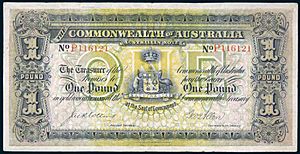 |
Collins and Allen | Front:Crowned arms, blue with multicolour background Back:Gold miners underground 184 mm × 92 mm (7.2 in × 3.6 in) |
|
| 1 Pound (1894) 1914–15 |
Collins and Allen Emergency issue superscribed note. |
Front:Picture of a woman with an anchor 182 mm × 118 mm (7.2 in × 4.6 in) |
||
| 1 Pound 1914–15 |
|
Collins and Allen Emergency issue note |
Front:Black text on multicolour background Back:Words from that time 184 mm × 102 mm (7.2 in × 4.0 in) |
|
| 1,000 Pounds 1914–24 |
|
Collins and Allen Kell and Collins (1925) |
Front:Arms Back:Merino sheep in Bungaree 215 mm × 143 mm (8.5 in × 5.6 in) |
|
|
|
10 Shillings 1915–18 |
|
Collins and Allen (1915) Cerutty and Collins (1918) |
Front:Arms, blue text multicolour background, "Half Sovereign" red overprint Back:Goulburn Weir 197 mm × 88 mm (7.8 in × 3.5 in) |
| 1 Pound 1913–18 |
|
Collins and Allen (1914) Cerutty and Collins (1918) |
Front:Crowned arms, blue with multicolour background Back:Gold miners underground 184 mm × 92 mm (7.2 in × 3.6 in) |
|
| 5 Pounds 1913–18 |
|
Collins and Allen Cerutty and Collins (1918) |
Front:Arms, blue with multicolour background Back:Hawkesbury River landscape 167 mm × 105 mm (6.6 in × 4.1 in) |
|
| 10 Pounds 1913–18 |
|
Collins and Allen Cerutty and Collins (1918) |
Front:Arms, blue with multicolour background Back:Wagons with bags of grain at Narwonah railway station 165 mm × 102 mm (6.5 in × 4.0 in) |
|
| 20 Pounds 1914–18 |
|
Collins and Allen Cerutty and Collins (1918) |
Front:Arms, blue with multicolour background Back:Lumberjacks at Bruny Island 165 mm × 98 mm (6.5 in × 3.9 in) |
|
| 50 Pounds 1914–18 |
|
Collins and Allen Cerutty and Collins (1920) |
Front:Arms, blue with multicolour background Back:Merino sheep, Bungaree 166 mm × 102 mm (6.5 in × 4.0 in) |
|
| 100 Pounds 1914–18 |
|
Collins and Allen Cerutty and Collins (1924) |
Front:Arms, blue with multicolour background Back:Leura Falls, Upper Yarra River 168 mm × 102 mm (6.6 in × 4.0 in) |
|
|
|
Half Sovereign 1923 |
|
Miller and Collins (1923) | Front:George V, brown with multicolour background, Half Sovereign overprint Back:Goulburn Weir 180 mm × 78 mm (7.1 in × 3.1 in) |
| 1 Pound 1923 |
|
Miller and Collins | Front:George V, olive-green with multicolor background Back:Cook's landing at Botany Bay 180 mm × 78 mm (7.1 in × 3.1 in) |
|
| 5 Pounds 1924–27 |
|
Kell and Collins (1924) Kell and Heathershaw (1927) |
Front:George V, blue with multicolour background Back:Hawkesbury River landscape 180 mm × 78 mm (7.1 in × 3.1 in) |
|
| 10 Pounds 1925 |
|
Kell and Collins (specimen only) |
Front:George V, red with multicolour background Back:Wagons with bags of grain 180 mm × 78 mm (7.1 in × 3.1 in) |
|
|
|
Half Sovereign 1926–33 |
|
Kell and Collins (1926) Kell and Heathershaw (1927) Riddle and Heathershaw (1928) Riddle and Sheehan (1933) |
Front:George V, brown with multicolour background, Half Sovereign overprint Back:Goulburn Weir 180 mm × 78 mm (7.1 in × 3.1 in) |
| 1 Pound 1926–32 |
|
Kell and Collins (1926) Kell and Heathershaw (1927) Riddle and Heathershaw (1927) Riddle and Sheehan (1932) |
Front:George V, olive-green with multicolor background Back:Cook's landing at Botany Bay 180 mm × 78 mm (7.1 in × 3.1 in) |
|
| 5 Pounds 1927–32 |
Riddle and Heathershaw (1927) Riddle and Sheehan (1932) |
Front:George V, blue with multicolour background Back:Hawkesbury River landscape 180 mm × 78 mm (7.1 in × 3.1 in) |
||
| 10 Pounds 1925–33 |
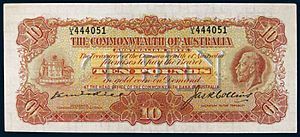 |
Kell and Collins (1925) Riddle and Heathershaw (1925) Riddle and Sheehan (1933) |
Front:George V, red with multicolour background Back:wagons with bags of grain at Narwonah railway station 180 mm × 77 mm (7.1 in × 3.0 in) |
|
|
|
10 Shillings 1933 |
Riddle and Sheehan (1933) | Front:George V, brown with multicolour background Back:Picture of manufacturing Watermark:Edward VIII as Prince of Wales 155 mm × 81 mm (6.1 in × 3.2 in) |
|
| 10 Shillings 1934 |
|
Riddle and Sheehan (1934) | Front:George V, brown with multicolour background, overprint Ten Shillings Back:Picture of manufacturing Watermark:Edward VIII as Prince of Wales 155 mm × 81 mm (6.1 in × 3.2 in) |
|
| 10 Shillings 1936–39 |
|
Riddle and Sheehan (1936) | Front:George V, orange with multicolour background, overprint Ten Shillings Back:Picture of manufacturing Watermark:Edward VIII as Prince of Wales, smaller size 137 mm × 76 mm (5.4 in × 3.0 in) |
|
| 1 Pound 1933–38 |
|
Riddle and Sheehan | Front:George V, green with multicolour background Back:shepherds with sheep Watermark:Edward VIII as Prince of Wales 155 mm × 79 mm (6.1 in × 3.1 in) |
|
| 5 Pounds 1933–39 |
|
Riddle and Sheehan | Front:George V, blue with multicolour background Back:dock workers with barrels and sacks Watermark:Edward VIII as Prince of Wales 181 mm × 79 mm (7.1 in × 3.1 in) |
|
| 10 Pounds 1934–39 |
|
Riddle and Sheehan | Front:George V, red with multicolour background Back:Picture of agriculture Watermark:Edward VIII as Prince of Wales 181 mm × 79 mm (7.1 in × 3.1 in) |
|
|
|
5 Shillings 1946 |
Armitage and McFarlane (not Issued) |
Front:George VI, black with red-brown background Back:Australian crown coin |
|
| 10 Shillings 1939–54 |
|
Sheehan and McFarlane (1939) Armitage and McFarlane (1942) Coombs and Watt (1949) Coombs and Wilson (1952) |
Front:George VI, orange with multicolour background Back:Picture of manufacturers Watermark:Captain James Cook 137 mm × 76 mm (5.4 in × 3.0 in) |
|
| 1 Pound 1938–52 |
|
Sheehan and McFarlane (1938) Armitage and McFarlane (1942) Coombs and Watt (1949) Coombs and Wilson (1952) |
Front:George VI, green with multicolour background Back:shepherds with sheep Watermark:Captain James Cook 155 mm × 79 mm (6.1 in × 3.1 in) |
|
| 5 Pounds 1939–52 |
|
Sheehan and McFarlane (1939) Armitage and McFarlane (1941) Coombs and Watt (1949) Coombs and Wilson (1952) |
Front:George VI, blue with multicolour background Back:dock workers with barrels and sacks Watermark:Captain James Cook 181 mm × 79 mm (7.1 in × 3.1 in) |
|
| 10 Pounds 1940–52 |
|
Sheehan and McFarlane (1940) Armitage and McFarlane(1943) Coombs and Watt (1949) Coombs and Wilson (1952) |
Front:George VI, red with multicolour background Back:Picture of agriculture Watermark:Captain James Cook 181 mm × 79 mm (7.1 in × 3.1 in) |
|
| 50 Pounds 1939 |
Sheehan and McFarlane specimen only, not issued |
Front:George VI, purple with multicolour background Watermark:Captain James Cook |
||
| 100 Pounds 1939 |
Sheehan and McFarlane specimen only, not issued |
Front:George VI, brown with multicolour background Watermark:Captain James Cook (likely) |
||
|
|
10 Shillings 1954–66 |
|
Coombs and Wilson (1954) Coombs and Wilson (1961) |
Front:Matthew Flinders, arms, brown with multicolour background Back:Old Parliament House Watermark:Captain James Cook 137 mm × 76 mm (5.4 in × 3.0 in) |
| 1 Pound 1954–60 |
|
Coombs and Wilson | Front:Elizabeth II, arms, green with multicolour background Back:Charles Sturt and Hamilton Hume Watermark:Captain James Cook 156 mm × 81 mm (6.1 in × 3.2 in) |
|
| 5 Pounds 1954–59 |
|
Coombs and Wilson | Front:Sir John Franklin, arms, blue on multicolour background Back:bull and cow's head, sheep Watermark:Captain James Cook 167 mm × 79 mm (6.6 in × 3.1 in) |
|
| 10 Pounds 1954–59 |
|
Coombs and Wilson | Front:Gov. Arthur Phillip, arms, red and black with multicolour background Back:Picture of a woman with a compass, science and industry 181 mm × 79 mm (7.1 in × 3.1 in) |
|
|
|
5 Pounds 1960–65 |
Coombs and Wilson | Front: Sir John Franklin, arms, black on blue background Back:bull and cow's head, sheep Watermark:Captain James Cook 167 mm × 79 mm (6.6 in × 3.1 in) |
|
| 10 Pounds 1960–65 |
Coombs and Wilson | Front:Gov. Arthur Phillip, arms, black with red background Back:Picture of a woman with a compass, science and industry Watermark:Captain James Cook 181 mm × 79 mm (7.1 in × 3.1 in) |
Images for kids


